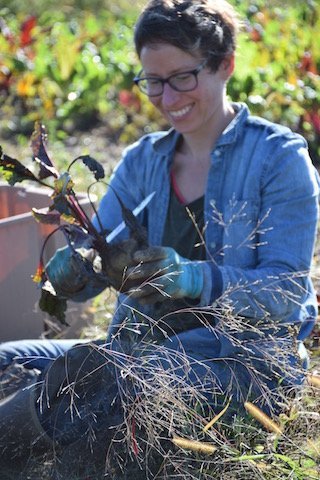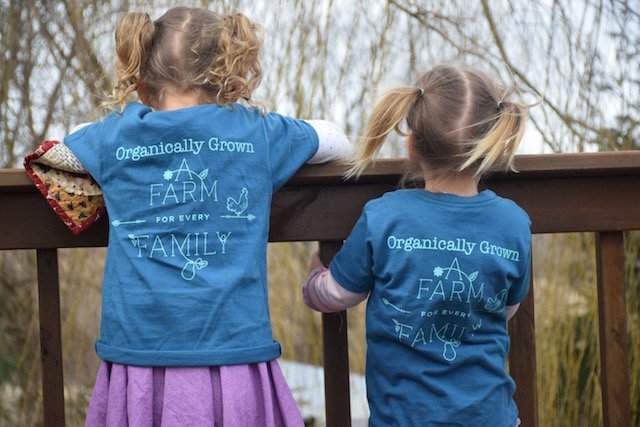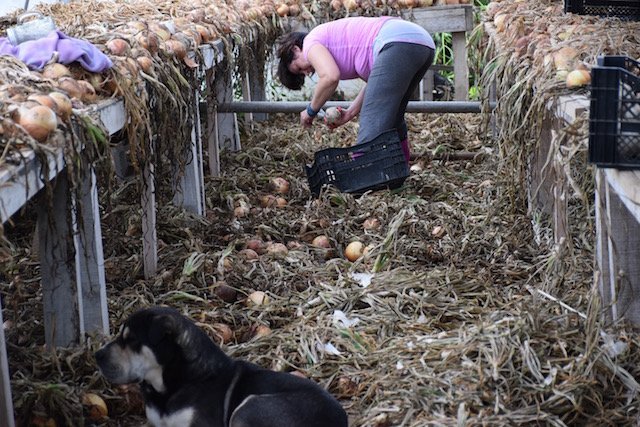
August Twenty Fourth
Community Supported Agriculture or CSA began in the United States with a farm in Massachusetts that was selling shares for apples, cider, and vinegar. The basic concept was born where what is produced locally is consumed locally. The CSA members were a core group of people who were actively interested in knowing where their food came from, that is was produced without the used of pesticides and harmful synthetic chemicals and were deeply concerned that the farm that the food was being grown on was reserved for agriculture and the production of clean food indefinitely.
Similar programs and efforts were happening simultaneously in Germany, Switzerland and Japan around the same time period. We were ‘ripe’ for this change you could say. And we have come so far since then. The number of CSA Farms out there is growing (an unknown total number but somewhere in the 1700s in the US) and there is fear that we are straying somewhat from the initial intent and dream that the creators had for the future of CSA.
Farm monogamy has been woven into the foundation of the idea. Finding a farm, like choosing a wife or a husband or a life-long friend is a good comparison. In some areas where there are dozens of CSA farms to choose from, people are farm-hopping and finding a new farm to ‘try out’ each year like a T-shirt or a brand of jeans. People are intrigued by the idea and excited about buying local produce-but are straying from the long-term relationship part of supporting a CSA farm. We would like for you to think of it as more like choosing a football team to support, a city to move to, a college to send your kids to, or what company to work for where you would remain loyal and committed to that team or place or company through the years of drought, flood or bounty.
As with any relationship that you may have, there is a beauty, richness and depth that reveals itself over time that simply cannot be felt or truly known without weathering the storm with a person over the years. There are many ways to buy organic food these days through farmer’s markets, grocery stores, CSA’s , and organic Food Co-ops ect. These are all blessings on the land and our community and it makes me feel hopeful.
But what makes CSA farming so special and unique is the relationship to a place. I’m not talking entirely about your relationship to me or Adam or our kids, because it’s not possible for us to be best friends with everyone. I am talking about a relationship to a place. Like having a place you call home and the image that comes to mind when you think about where your food comes from. The big, red buildings, the Maple Tree on the ridge, the tractors, the gravel lane, the familiar grounds. You eat the food from this place week after week, year after year, and suddenly it becomes your farm. Adam and I are merely the stewards for this brief passing of history. And when we are gone, maybe this farm will be run by one of the children in this community and the profundity of history will be a beautifully layered component.
If you find a farm to know and love you will experience the blessings of wonder, relationship, and commitment. You will feel love for the place and also feel loved by the place. You will create a history and develop stories that are your own. It is okay to have love for many farms, but while remaining grounded and rooted in the one love you have for your farm. I have a farm in my heart and it will be the same farm for my whole life.
Sooo…What’s in the Box???
Red Watermelon– Ana is the variety of this watermelon. A red, seedless watermelon that we are very happy with this year. You can’t be sad if you have a watermelon on your countertop!
Summer Squash and Zucchini- We’re down to harvesting the very last of the Summer Squash and Zucchini this week. Probably this will be our final squash giving of the year. Summer squash and zucchini also prefer 50 degree storage.
White Onions- Another week of whole onions. The onions are all harvested and laid out and looking beautiful on the curing tables in the greenhouse.
Hungarian Hot Wax Pepper- These peppers are also known as ‘Banana peppers’. They are most commonly seen lime green or a yellow-ish color. When they are ‘ripe’ they turn orange or red which sometimes makes them a little sweeter. Hungarian Hot Wax, despite their intimidating name are amidst one of the most mild of all hot peppers out there. For a Woose like me, they’re perfect!
Jalapeno Pepper- One of these little guys per box. Jalapenos pack a little more heat than the Hungarian Hot Wax peppers. We recommend wearing gloves if you go to cut these up!
Sweet Corn- 3 Ears per member. Adam wanted me to tell you all that this sweet corn should be called just “Corn” and not “Sweet Corn” because it’s not very sweet. He was very disappointed in this variety and didn’t like it as much. But, this is what we grew and this is what we have. Better luck for next year. Sweet corn needs to stay very cold in order to keep its sweetness. Sweet corn does not keep well outside of the refrigerator, despite the fact that you see it being sold by truck farmers in parking lots outside of refrigeration. Eat it up ASAP for the best flavor! The sugars turn the starches very quickly once it has been picked!
Sweet Bell Peppers- Three to 4 sweet peppers per member this week. You may have received either red, orange and/or yellow peppers this week. A wonderful addition to your salsas, stir frys and salads!
Lunchbox Sweet Peppers- Everyone received about four little, small sweet peppers that could be mistaken for a hot pepper, but they are not hot. They usually come in red, yellow and orange colors. We grew these little guys last year for the first time and totally fell in love with them! Eat these for a snack raw, or cook with them like you would any other sweet bell pepper.
Eggplant- Either one standard eggplant per member or 1-2 Japanese eggplants. Eggplant prefers 50 degree storage, so there isn’t really a great way to keep them. You choose, the counter or the fridge. They’re really the best if you just use them up quickly!
Sun Gold Cherry Tomatoes- We were able to pick one pint for everyone this week! These are my personal favorite of all kinds of tomatoes! These little sungolds are packed with flavor and sunshine and good for your tummy and heart gloriness!
Tomatoes- The beginning of the tomatoes! We were able to give everyone a whopping 6.3lbs of tomatoes this week. We pick any tomato with a ‘blush’ or any shade of red, yellow or orange. We grow many different kinds of tomatoes and some are romas, some are heirlooms and some are standard slicing tomatoes. We grow many different colored tomatoes as well. Don’t wait for your tomatoes to all turn a bright red color, some of them ripen pink or yellow or orange. You will know when they are ripe if you give them a very gentle squeeze and they are soft and not firm anymore. Do not put your tomatoes in the fridge as their flavor with diminish. We recommend leaving your tomatoes on your countertop to ripen if they are slightly under ripe. Only if they are very ripe and you are in danger of loosing them should you put them in the fridge if you can’t eat them up promptly.
Green Beans mixed with Dragon Tongue Beans- Some bags were mixed with Dragon Tongue and some were not. 1.1 pounds of beans per member this week! We planted a row of green beans right next to a row of Dragon Tongue Beans. The Dragon Tongues are a larger, more flat type bean that is yellow with purple streaking. The purple color will go away once the bean is cooked. We tried to give everyone a mix of both types of beans.
Carrots- One pound of carrots this week per member. We snapped the tops off of the carrots this week because the tops of the carrots are starting to dye back and it made it a little easier for us to wash and bag them rather than sit in the fields and bunch them with their tops on. Still very fresh carrots harvested on Monday morning by loving hands.
Romanesco- These are the fractal looking vegetable. They are in the same family as broccoli and cauliflower. It snaps apart in the same way that a cauliflower does into little florettes and has a pleasant nutty flavor when compared to broccoli or cauliflower. Enjoy the funky look of this veggie as you eat it!
Garlic- One head of garlic per member this week. This is the Armenian hardneck porcelain variety. Armenian garlic have four to five large cloves per bulb. It is a nice kitchen garlic because you don’t have to peel 15 different small cloves, it has just four or five very large cloves.
Next Weeks Best Guess:
Sweet Peppers, tomatoes, onion, beets, eggplant, hungarian hot wax pepper, jalapeno pepper, garlic, green beans, romanesco?, lunchbox peppers, cilantro, green curly kale, potatoes, cherry tomatoes
Recipes